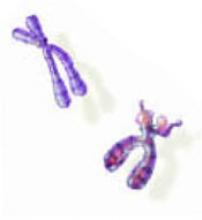User login
<huc>Q</huc> I have a patient with a BRCA mutation that places her at high risk for breast and ovarian cancer. Which diagnosis code should I use?
<huc>A</huc> If you are removing the organ, use V50.42 (prophylactic ovary removal) or V50.49 (other prophylactic organ removal) as the primary diagnosis.
If you simply want to note the mutation as a reason for further evaluation and management (E/M), try V16.3 (family history of breast cancer) or V16.41 (family history of ovarian cancer). You may use these as the primary diagnosis if there is no other reason for the encounter, or as secondary diagnoses.
Current ICD-9 rules do not permit you to code V83.89 (other genetic carrier status) for this scenario. This code is used for patients who carry a disease that can be directly passed on to their offspring, rather than for those at high risk of disease due to genetic predisposition.
ICD-9 has addressed this issue with new codes that go into effect October 1. They will be V84.01 (genetic susceptibility to malignant neoplasm of breast) and V84.02 (genetic susceptibility to malignant neoplasm of ovary). (Look for further discussion of this and other ICD-9 changes in the November issue of OBG Management).
<huc>Q</huc> I have a patient with a BRCA mutation that places her at high risk for breast and ovarian cancer. Which diagnosis code should I use?
<huc>A</huc> If you are removing the organ, use V50.42 (prophylactic ovary removal) or V50.49 (other prophylactic organ removal) as the primary diagnosis.
If you simply want to note the mutation as a reason for further evaluation and management (E/M), try V16.3 (family history of breast cancer) or V16.41 (family history of ovarian cancer). You may use these as the primary diagnosis if there is no other reason for the encounter, or as secondary diagnoses.
Current ICD-9 rules do not permit you to code V83.89 (other genetic carrier status) for this scenario. This code is used for patients who carry a disease that can be directly passed on to their offspring, rather than for those at high risk of disease due to genetic predisposition.
ICD-9 has addressed this issue with new codes that go into effect October 1. They will be V84.01 (genetic susceptibility to malignant neoplasm of breast) and V84.02 (genetic susceptibility to malignant neoplasm of ovary). (Look for further discussion of this and other ICD-9 changes in the November issue of OBG Management).
<huc>Q</huc> I have a patient with a BRCA mutation that places her at high risk for breast and ovarian cancer. Which diagnosis code should I use?
<huc>A</huc> If you are removing the organ, use V50.42 (prophylactic ovary removal) or V50.49 (other prophylactic organ removal) as the primary diagnosis.
If you simply want to note the mutation as a reason for further evaluation and management (E/M), try V16.3 (family history of breast cancer) or V16.41 (family history of ovarian cancer). You may use these as the primary diagnosis if there is no other reason for the encounter, or as secondary diagnoses.
Current ICD-9 rules do not permit you to code V83.89 (other genetic carrier status) for this scenario. This code is used for patients who carry a disease that can be directly passed on to their offspring, rather than for those at high risk of disease due to genetic predisposition.
ICD-9 has addressed this issue with new codes that go into effect October 1. They will be V84.01 (genetic susceptibility to malignant neoplasm of breast) and V84.02 (genetic susceptibility to malignant neoplasm of ovary). (Look for further discussion of this and other ICD-9 changes in the November issue of OBG Management).
